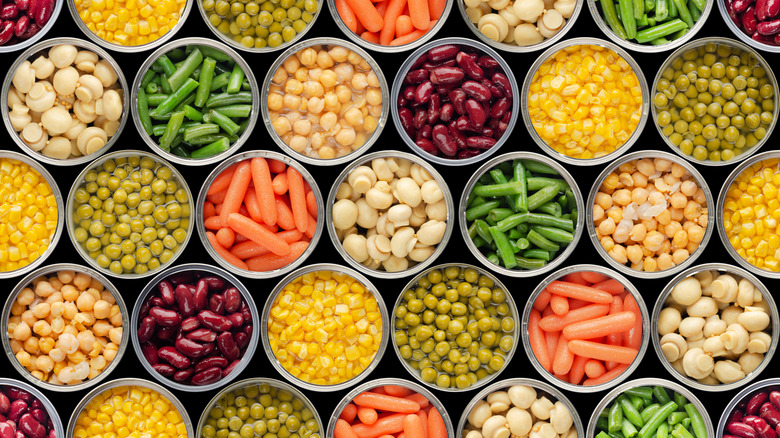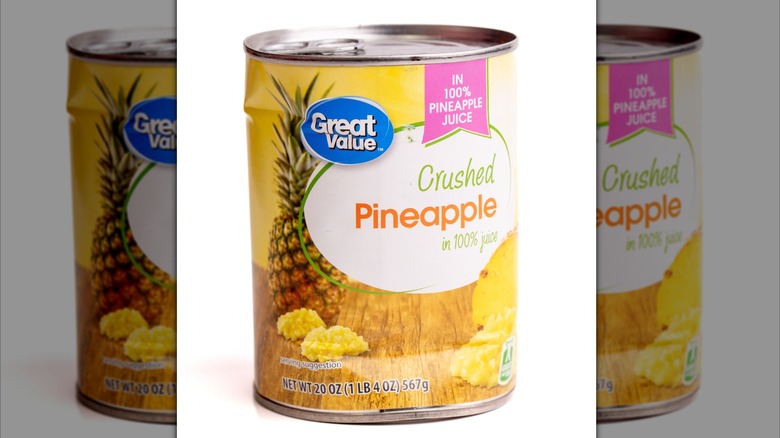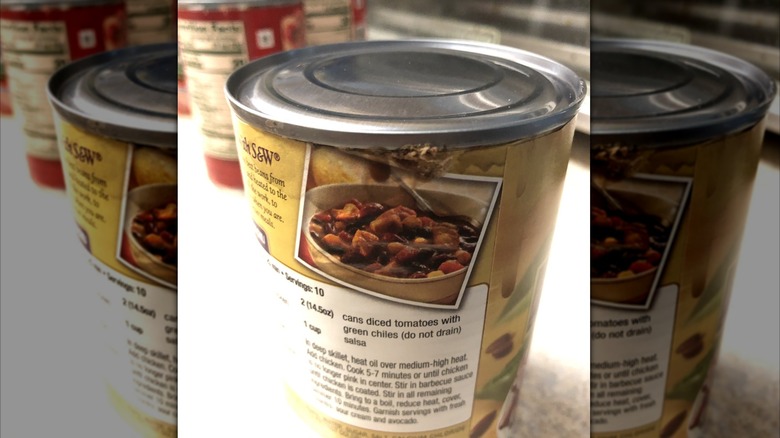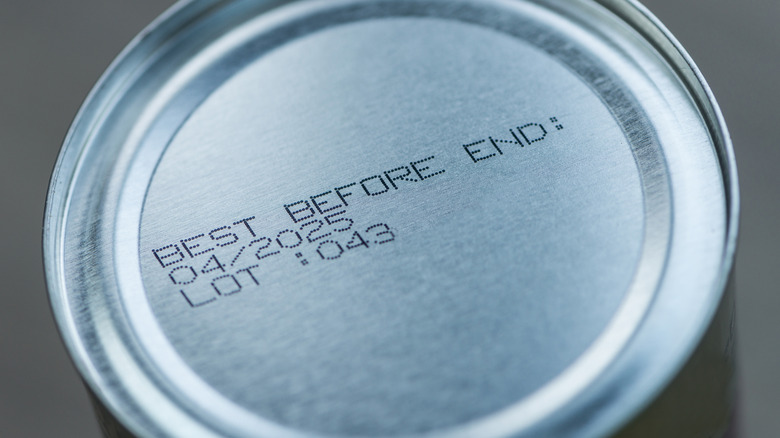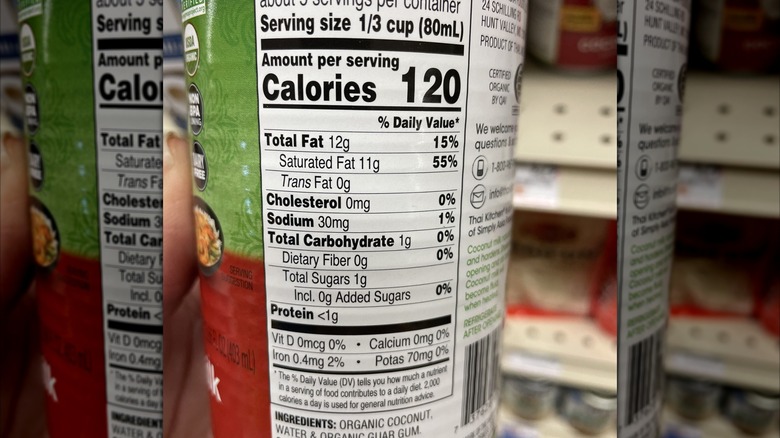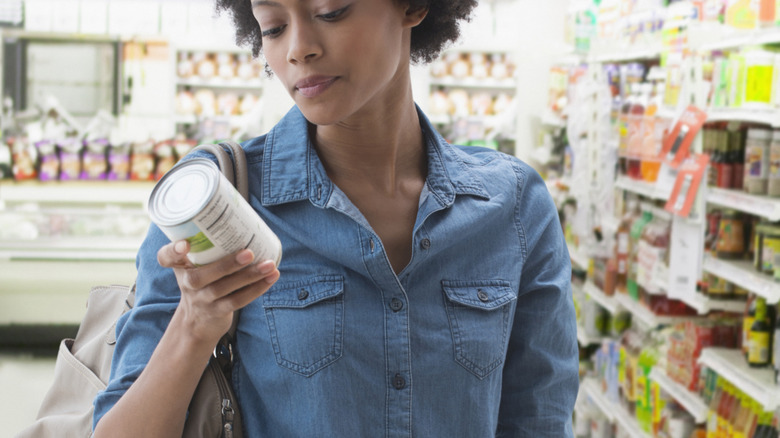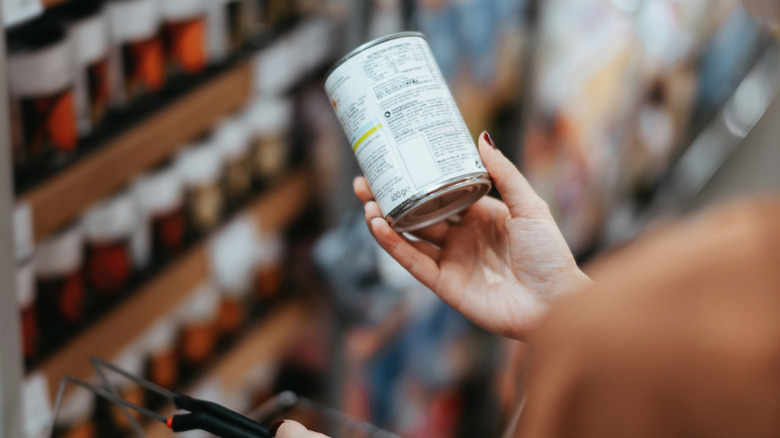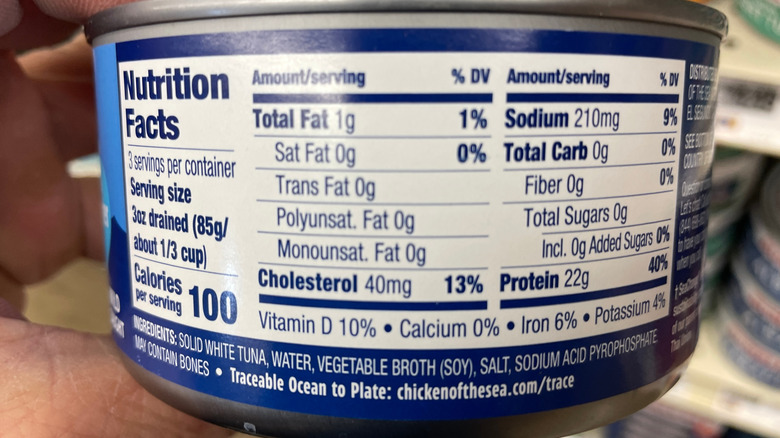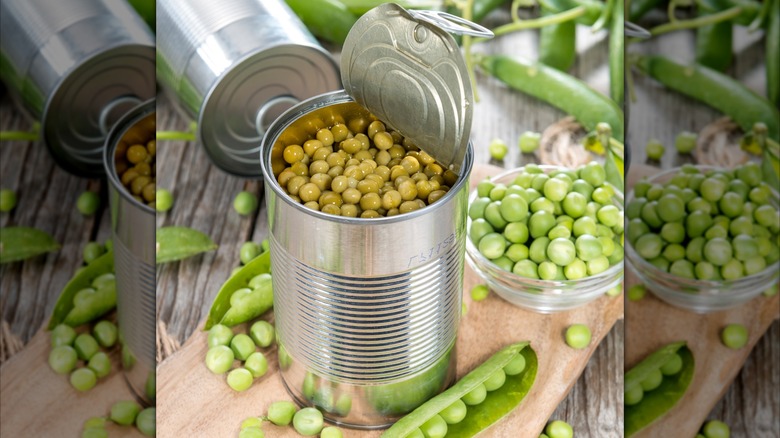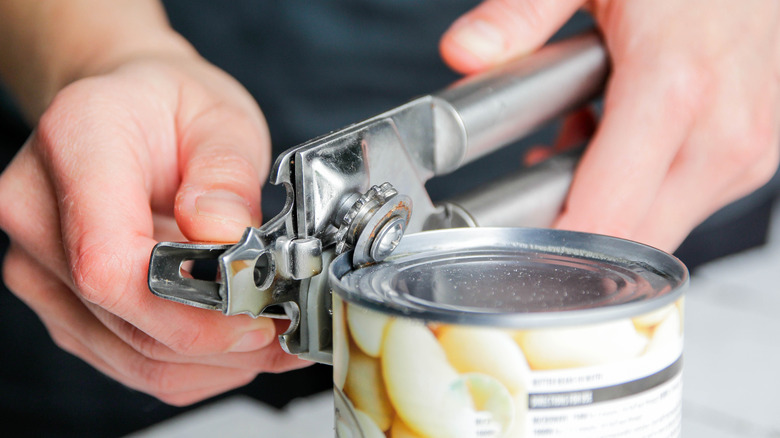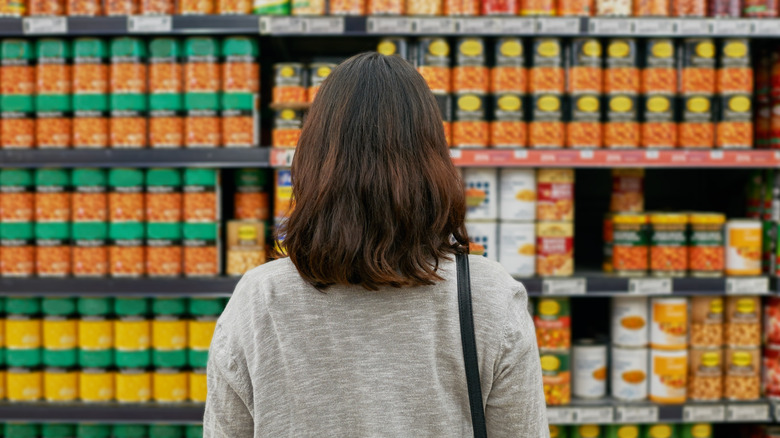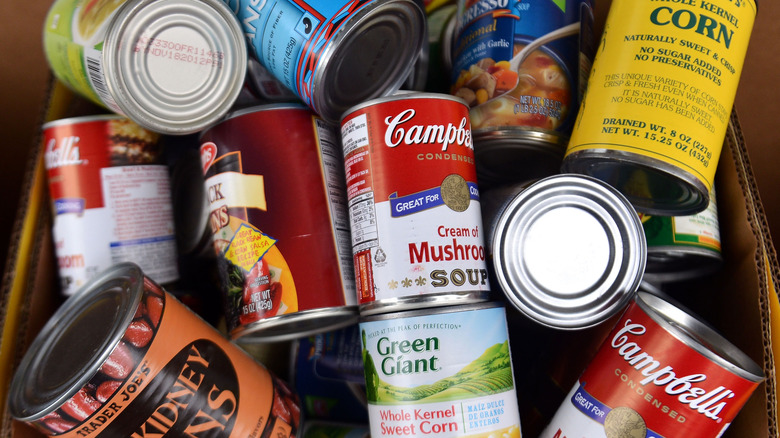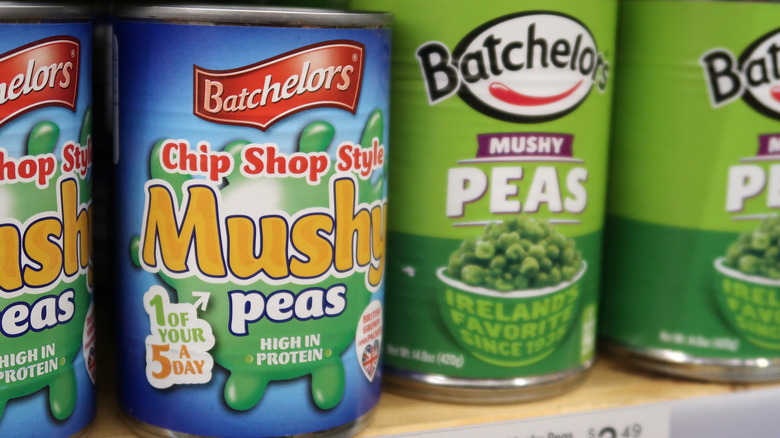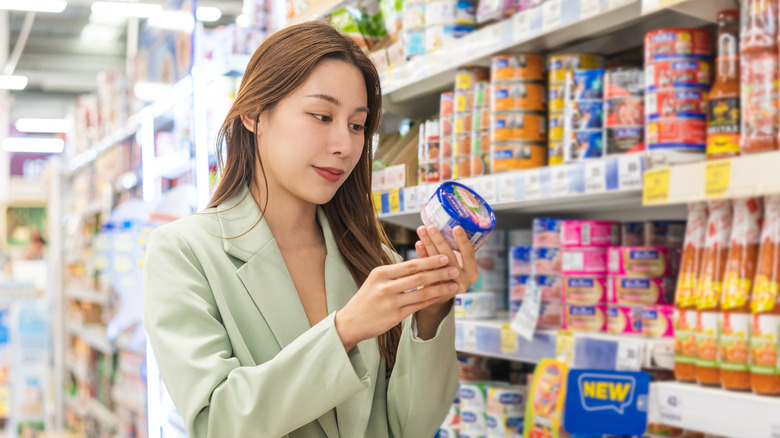13 Red Flags To Look Out For When Buying Canned Foods
Stocking your pantry with a colossal collection of canned goods lets you have food on hand whenever your recipe-loving heart gets the itch for culinary experimentation. It also makes having a one-can dinner on hand for easy eating a sweet possibility for those evenings when cooking something complex sounds like too much work. With longevity, easy storage, and a plethora of potential lying in wait in your local grocer's canned food aisles, your options for stacking the shelves in your favor are practically limitless.
But shopping for proper canned food can be trickier than expected, especially with the abundance of canned food myths floating around the shopping world. Despite the best efforts of food producers, sometimes the contents of the can you buy aren't as fresh or wholesome as they should be. Pricing can also be the problem, especially when competition between brands and locations is fierce, as it usually is. Luckily, there are some handy red flags that can help you identify the best buys for your canned food budget that let you swerve around the cans that need to be canned.
1. Dents
Anyone shopping in the clearance section of their favorite grocery store will surely recognize the cans that come with a dent and are sold at deep discounts. While the temptation is high to grab as many as you can and toss them in your cart, you should always make sure that any dents present have not resulted in the outer surface of the can being pierced. If the contents of the can have been exposed to air for any reason, they've also been exposed to bacteria, which means they are not likely to be safe for consumption.
Understanding that it's safe to eat from dented cans as long as the dents are small and the can is still intact can make quite a difference in your grocery bill. Stores regularly find dented stock that doesn't sit properly on shelves but is still entirely saleable and edible. Inspect any cans you find in the markdown section to make sure they're still sealed before stocking up on your enticingly inexpensive goods.
2. Bulges
Sometimes you find a can that's round out a little on the lid or the sides, a noticeable bulge that breaks the linear contours of the can itself. This type of bulge is a sign of potential contamination inside the can, even if it hasn't been opened. Many cans contain ripples in the top or sides that allow the metal to expand slightly without bursting. Though the design may accommodate these potential bulges, the feature is strictly to allow a bit of natural expansion and avoid messes while the cans are shipping or sitting on shelves. Compromised canned food with any sort of altered contours should not be sold despite the misshapen container still being whole and unopened.
Because bulges indicate the growth of bacteria, you should never trust bulging cans to be consumable; if you discover any in your pantry, throw them away immediately. And if you stumble across cans with rounded tops or bumped-out sides in the store while you're shopping, report your find to store management so they can take action and remove the troubling cans from store shelves.
3. Best Used By Dates
Generally printed on top or bottom of the cans, "best used by" dates provide a timeframe for the food inside the can to be at peak freshness. Though the FDA advises that these dates don't always indicate the true expiration of the product — meaning it's no longer consumable after the date shown — and that canned goods can remain edible pretty much forever as long as they don't show bulges or rust, your best practice should be to keep track of the dates as you purchase your canned food. This will help you avoid buying cans that may not be as fresh as you'd like them to be when you're ready to use them, even if they're still edible.
Sometimes, you don't realize you're in possession of canned food that's less than fresh until you crack the lid. Scanning several cans while you're still in the store will let you know if there are fresher goods lying in wait among the older items. Though stores usually sell through canned goods pretty quickly, less popular picks may sit on shelves longer than they should. Even a single older can may get stuck among newer stock. A quick glance at the dates will clue you in on the potential quality of your purchase.
4. High Sodium Content
Something has to keep the contents of the can preserved until you are ready to open it and eat them. The canning process is designed to seal out air, thereby protecting the interior from exposure to bacteria. But to keep the food inside fresh for as long as possible, vegetable companies usually can their products using a considerable amount of salt. This translates to a higher-than-desirable sodium content, which may not simply impact the taste of the food in the can, but may also compromise the healthful nature of canned vegetables.
The unhealthiest canned foods you'll find on store shelves are often the ones with the most sodium, even if you're choosing basic staple items. To eliminate as much sodium as possible from items like beans and corn, drain and rinse the contents of the cans to get rid of the liquid. Minimize sodium even further by reducing salt added to your recipe to balance out what might be retained in the canned veggies even after they've been rinsed.
5. High Sugar Content
Canned fruit is an excellent way to keep nutritious possibilities on hand without having to worry about eating it right away. The stickler with these shelf, stable slices and cocktails are the incredibly high sugar content that sometimes rides shotgun. Whether you find fruit canned in heavy syrup, light syrup, juice, or water, you should always eye up the label to find out just how much sugar you're purchasing along with your peaches or mandarin segments.
Though reading the nutrition facts will let you know the numbers regarding the sugar in the can, the various types of sugar found in canned fruits can be confusing. A simple breakdown of the sugar types you may find listed on labels: light syrup, which is sugar dissolved in water; heavy syrup, which includes corn syrup; and fruit juice, which often contains a high sugar count in addition to what's found in the fruit itself. You can also get a sense of the sugar factor by noting the total sugar versus the added sugar, which comes from the syrups and juices rather than the fruit. This will help you decide which canned fruit you should and shouldn't buy based on your dietary needs.
6. Artificial Sweeteners
Just as concerning as sugar-based sweeteners in canned food, some products contain artificial sweeteners that can be troubling if you have sensitivities to these chemicals. Sometimes these ingredients are included in addition to natural and added sugars, and other times they're included in place of them. Unless the label states somewhere on the front that the contents are sugar-free or low sugar, reading the ingredients list will help you determine what's true. And it's always easier to check while you're still in the store than it is to get home and discover you've bought an item with an artificial sweetener you weren't expecting.
Sometimes, artificial sweeteners appear in food products you might not expect, items like pasta sauces and fruit. You may see them listed by common names like sucralose and aspartame, or you may find them in the form of acesulfame potassium and Stevia. Each sweetener comes with its own flavor profile that may alter the flavor of the food inside the can considerably, especially foods where sugar or sweetener of any kind isn't expected.
7. Additives
Thickeners, chemical dyes, and flavorings may be unexpected when purchasing canned food. But these red flag substances can make surprise appearances that you don't catch until you've already finished your shopping and made it home with your wares. Careful examination of the ingredients list will reveal just how much of what's in the can shouldn't be, especially if you're hoping for healthful eating from your cabinet collection.
Some substances to keep an eye out for when scanning your canned food labels include carrageenan, guar gum, and xanthan gum, all food-safe thickeners used for richer textures that may cause issues for people who are sensitive. Cautious shoppers can also keep track of synthetic petroleum-based dyes like red 40, yellow 5, and yellow 6; these are synthetic and not considered healthy inclusions in canned food, or food of any kind. Artificial and natural flavorings may be listed without further description, which means the origins of the substance providing the flavor isn't clear. For plant-based eaters avoiding animal-based ingredients, it's best to keep away from cans listing these tricky add-ins.
8. BPA Lining
One of the most insidious red flags thrown up by the canned food industry is the use of a chemical called Bisphenol A, or BPA, to line can interiors. Though BPA was long used to create a rust-proof barrier between the food and the metal, studies have tied this troubling substance to damage in many major systems, including cardiovascular and neurological issues. This began a movement of non-BPA lined cans, a feature that's often called out on the label to alert, discerning shoppers that they're making a wise purchase. Environmental group EWG reports that as of 2019, 96% of all cans were BPA-free, though there are still outliers lurking on shelves that can be difficult to identify.
It's difficult to tell even once you've opened a can whether or not it's lined with BPA; other chemical sealants may be present instead. Finding cans labeled "non-BPA lined" provides a better chance of avoiding these substances, though you can also confirm with manufacturers how the coding stamped on top or bottom of the can relates to the composition of the can lining. Then, you can make more informed decisions about which brands to buy.
9. Metal Exposure and Rust
It may seem like an unnecessary final step after taking precautions for all the other red flags before buying your preferred canned food items, but once the can is open, it's important for you to inspect the lid and interior walls for the presence of rust. This troublesome residue can arise from areas where unfinished metal touches liquid, especially acid heavy fluids like those found in tomato sauces. Per the USDA, finding rust on the outer surface of the can may not indicate rust inside, though you should be prepared to examine the contents closely. You should also remove the rust on the outside of the can with a rag or paper towel.
The unfortunate fact about rust is that any contamination in the can might make the food inside entirely inedible. Should you find rust once you've popped the top of your canned food, it's worth a call to your grocer to find out if you were eligible for an exchange, store credit, or a refund. It's also crucial to know that leaving your open can sitting on the counter for too long can start a rust reaction on the lid or rim of the can. If this happens, dispose of the can and open a new one.
10. Store Brand vs. National Brand Quality
When searching for vegetables you should buy canned, it's tempting to go for the store brand with its lower prices rather than springing for the more expensive national brand. But a bit of quality testing may reveal instances in which the national brand is worth the extra money, especially if you intend to use your canned ingredients for a special occasion. Having the freshest, most flavorful elements to work your culinary wonders is a big consideration, one the store labels don't always account for when mass producing canned food for general consumption.
For any canned items where taste and texture are critical, buy a test can from both national and store brands, and perform your own taste test to see which works better. Then, make note of your findings for future shopping trips. You may find Bush's chickpeas are softer and more robust than Great Value, and you might be willing to fork over a bit more to put better quality goods at the end of your own fork.
11. Single Can vs. Bulk Pricing
You may notice certain canned goods like beans and corn are shelved in multi packs of four or more, the basic grocery stores version of warehouse bulk offerings. The price on these multi packs may be attractive and the idea of stocking up on staples in one fell swoop is enticing. Cautious shoppers know better than to be wooed by the allure of an easy bargain; novice shoppers may be accustomed to the idea that these bulk packs don't always save you money. Sometimes you can find better prices on individual cans; all it takes is a bit of simple price comparison by item and by content, weight, and serving number to determine which is the better deal for you.
When stocking your pantry with canned vegetables to be used for large meals or to prevent frequent shopping trips, you're likely to find better bulk prices at warehouse stores like Costco and Sam's Club than at standard grocery stores. If your favorite shop stocks four-packs of its signature label offerings, be sure to total up what the same number of cans might cost if you bought them individually, and remember to take coupons and sales into consideration.
12. Country of Origin
Depending on where you shop, you may find canned goods imported from locations around the world, filled with foods that you can't easily get in the U.S. The presumption is that all of these cans are safe for consumption and usually cost-effective, since their rarity may mean that whatever price you find is the best price available. The truth is, you should be aware of the possibilities for differing food safety standards in different countries. If you're ordering canned food online, be sure to research the standards in the country of origin so you can make the most informed purchase possible.
If you're visiting abroad and shopping for canned food with the intent of bringing it back to the states to enjoy, you'll want to check with U.S. Customs to see if you're allowed to carry your purchases into the country. Certain canned items like meats that come from countries where Mad Cow Disease is more prevalent are not permitted, even if purchased somewhere seemingly allowable like Canada.
13. Competitive Store Pricing
You already know how competitive grocery chains can be when it comes to pricing their commonly-shelved goods. Canned food is prime among this contentious practice, with some stores charging twice as much or higher as their fellow outlets. It's easy enough to line up your options in-store to compare quantities and prices to decide whether the store provides your favorite brands within your price range. A quick internet check can reveal whether other stores and online outlets like Amazon can stretch your already-tight shopping dollars even further.
There's also the question of lesser-known store brands, which are often priced more competitively than national brands while providing similar quality. Though it's not guaranteed that a can of Kroger black beans will deliver the same freshness and flavor as a can of Bush's or Goya, the price factor is a solid determiner for whether it's worth giving the in-house label a try. The difference is sometimes 50% or more. With sales and digital coupons, you can clean house with signature selections that make your money go further, while fantastically feeding yourself and your family.
